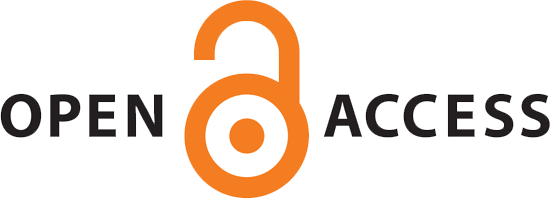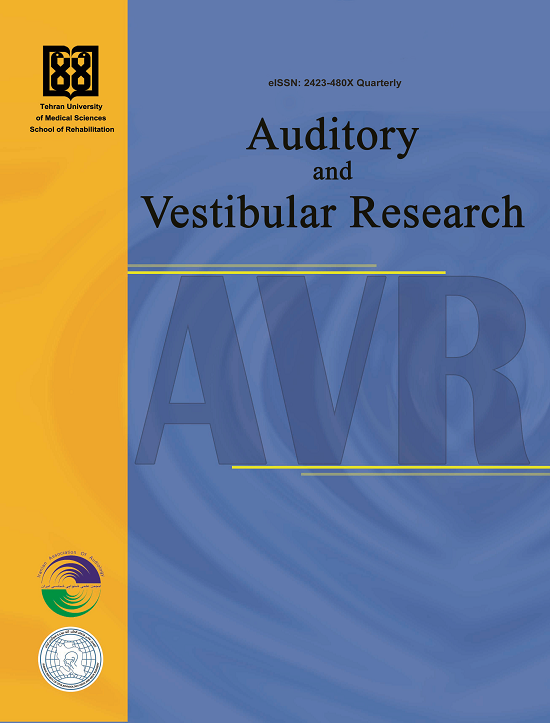Gap Detection Threshold in Children with Down Syndrome: A Brief Report
Abstract
Background and Aim: Auditory discrimination is one of reasons for low performance of phonological processing in people with Down syndrome. This study aims to evaluate the auditory discrimination performance of children with Down syndrome to explore a reason for deficit in phonological processing in these children.
Methods: In this descriptive cross-sectional study, 16 Persian-speaking elementary school male students with Down syndrome participated. Phonetic gap detection test was used to evaluate their auditory temporal threshold. They were asked to discriminate the sounds of six syllables at 20, 50, 100, 200 and 300 ms temporal gaps.
Results: The mean of phonetic gap detection threshold was 246.8 ms, ranged 183.3–300 ms. There was no significant correlation between auditory temporal thresholds and the factors of age or intelligence quotient.
Conclusion: Children with Down syndrome discriminate the sounds of syllables at higher thresholds compared to normal peers examined in previous studies. Increased gap detection threshold may be an underlying cause for low performance of these children in phonological processing.
2. Sayyahi F, Boulenger V. A temporal-based therapy for children with inconsistent phonological disorder: A case-series. Clin Linguist Phon. 2023;37(7):655-81. [DOI:10.1080/02699206.2022.2075792]
3. Coppens-Hofman MC, Maassen BAM, van Schrojenstein Lantman-de Valk HMJ, Snik AFM. Hearing disorders and auditory speech processing difficulties in adults with down syndrome: a review of the literature. J Hear Sci. 2011;1(3):11-7.
4. Sable JJ, Gratton G, Fabiani M. Sound presentation rate is represented logarithmically in human cortex. Eur J Neurosci. 2003;17(11):2492-6. [DOI:10.1046/j.1460-9568.2003.02690.x]
5. Luo H, Poeppel D. Cortical oscillations in auditory perception and speech: evidence for two temporal windows in human auditory cortex. Front Psychol. 2012;3:170. [DOI:10.3389/fpsyg.2012.00170]
6. Pekkonen E, Osipova D, Sauna-Aho O, Arvio M. Delayed auditory processing underlying stimulus detection in Down syndrome. Neuroimage. 2007;35(4):1547-50. [DOI:10.1016/j.neuroimage.2007.01.036]
7. Wolpaw JR, Penry JK. A temporal component of the auditory evoked response. Electroencephalogr Clin Neurophysiol. 1975;39(6):609-20. [DOI:10.1016/0013-4694(75)90073-5]
8. Sayyahi F, Soleymani Z, Akbari M, Bijankhan M, Dolatshahi B. Effect of gap detection threshold on consistency of speech in children with speech sound disorder. Res Dev Disabil. 2017;61:151-7. [DOI:10.1016/j.ridd.2016.12.004]
9. Muniz LF, Roazzi A, Schochat E, Teixeira CF, de Lucena JA. [Temporal processes ability evaluations with pure tones in children with and with no phonological disorders]. Audiologia Rev CEFAC. 2007;9(4):550-62. Portuguese. [DOI:10.1590/S1516-18462007000400016]
10. Muluk NB, Yalçinkaya F, Keith RW. Random gap detection test and random gap detection test-expanded: Results in children with previous language delay in early childhood. Auris Nasus Larynx. 2011;38(1):6-13. [DOI:10.1016/j.anl.2010.05.007]
11. Martikainen AL, Savinainen-Makkonen T, Kunnari S. Speech inconsistency and its association with speech production, phonological awareness and nonword repetition skills. Clin Linguist Phon. 2021;35(8):743-60. [DOI:10.1080/02699206.2020.1827296]
12. Kent RD, Vorperian HK. Speech impairment in Down syndrome: a review. J Speech Lang Hear Res. 2013;56(1):178-210. [DOI:10.1044/1092-4388(2012/12-0148)]
13. Rolfe CR, Montague JC Jr, Tirman RM, Vandergrift JF. Pilot perceptual and physiological investigation of hypernasality in Down’s syndrome adults. Folia Phoniatr (Basel). 1979;31(3):177-87. [DOI:10.1159/000264164]
14. Rosyidah RH. Understanding the Difficulties in Communication with Down Syndrome. Journal of English Teaching & Applied Linguistics. 2024;5(2):154-63. [DOI:10.36655/jetal.v5i2.1496]
| Files | ||
| Issue | Vol 34 No 2 (2025) | |
| Section | Short Article(s) | |
| DOI | https://doi.org/10.18502/avr.v34i2.18062 | |
| Keywords | ||
| Auditory temporal processing phonological processing intellectual disability working memory auditory discrimination auditory acuity | ||
| Rights and permissions | |

|
This work is licensed under a Creative Commons Attribution-NonCommercial 4.0 International License. |






